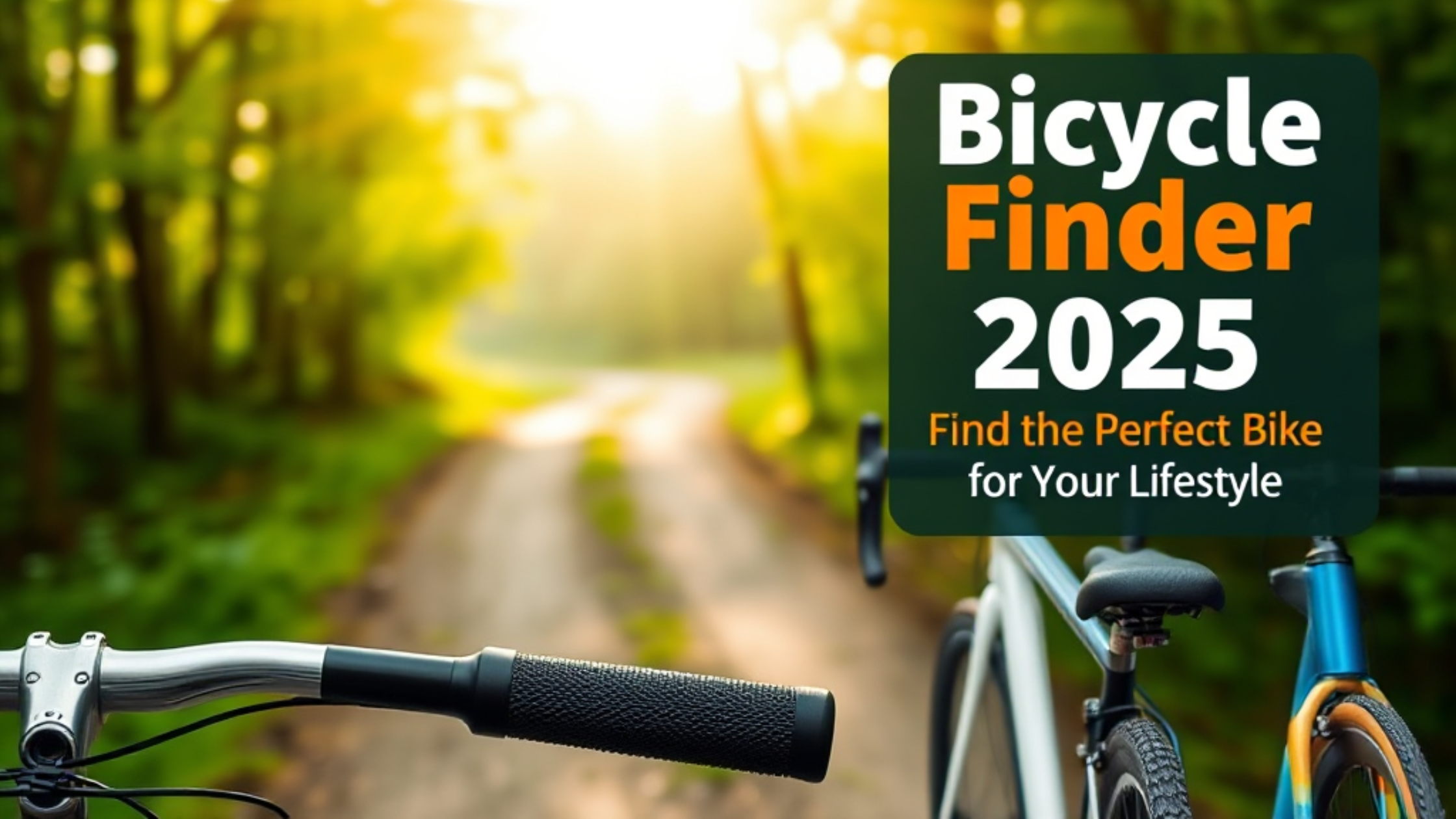Bicycle Finder. Welcome to the exciting world of cycling! Whether you’re dreaming of fast rides on open roads, tackling rugged mountain trails, or simply cruising around your neighbourhood, finding the right bicycle Finder can make all the difference. With so many choices out there, picking the “perfect” bike might seem a bit tricky. But don’t worry! This guide is here to help you navigate the options, understand what matters most, and confidently choose a bike that fits your life like a glove. Bicycle Finder
Think of your bike as a partner in your adventures. Just like you wouldn’t wear hiking boots to a swimming pool, you wouldn’t want a racing bike for bumpy off-road trails. This 2025 guide will walk you through everything you need to know, from understanding different bike types to learning about important features, finding the right size, and even where to buy. Let’s get ready to roll! 🚴♀️
Key Takeaways
- Know Your Why: Before anything else, figure out why you want a bike and where you’ll ride it. This is the most important step!
- Bike Types Matter: Different bikes are built for different jobs. Road bikes are for speed, mountain bikes for trails, and hybrid bikes are a great mix for everyday riding.
- Size It Up: A bike that fits you well is key for comfort, safety, and fun. Don’t guess your size; measure and test ride!
- Set Your Budget: Bikes come at all price points. Decide how much you’re willing to spend, remembering to save a little extra for important gear like a helmet.
- Test Ride is Best: No matter how much research you do, actually riding a bike before you buy it is the best way to know if it’s the right one for you. Bicycle Finder
Understanding Your Needs: The First Pedal Stroke
Before you start looking at shiny new bikes, take a moment to think about what you really need. This helps narrow down your choices a lot! Ask yourself these questions: Bicycle Finder
1. Why Do You Want a Bike? 🤔
Are you looking for a bike to:
- Commute to work or school? You’ll need something reliable, comfortable, and possibly with space for bags.
- Get fit and exercise? You might want a bike that helps you go faster or tackle challenging terrain.
- Explore nature trails? A bike built for off-road adventures will be essential.
- Run errands and carry groceries? A sturdy bike with racks might be perfect.
- Just for fun and casual rides with friends or family? Comfort and ease of use will be top priorities.
- Race or compete? You’ll be looking for a high-performance machine.
2. Where Will You Ride? 🗺️
The type of ground you’ll be riding on makes a huge difference:
- Smooth, Paved Roads: Think city streets, bike paths, and open highways. You’ll want a bike that rolls fast and smoothly.
- Light Trails/Gravel Paths: These are unpaved, but generally flat and not too rough, like park trails or dirt roads. A versatile bike is good here.
- Rough Mountain Trails: Steep climbs, rocky descents, roots, and bumps. This calls for a bike built to handle tough conditions.
- Mixed Terrain: A bit of everything – road, gravel, maybe some light dirt. A “do-it-all” bike could be your best friend.
3. How Far and How Often Will You Ride? ⏱️
- Short trips (a few miles): Comfort and convenience are key.
- Medium distances (5-15 miles): Efficiency and a comfortable riding position become more important.
- Long distances (20+ miles): Lightweight, aerodynamic, and highly efficient bikes will make these rides enjoyable.
- Daily riding vs. weekend fun: If you ride every day, durability and low maintenance are big pluses. Bicycle Finder
Answering these questions honestly will guide you towards the perfect category of bikes.
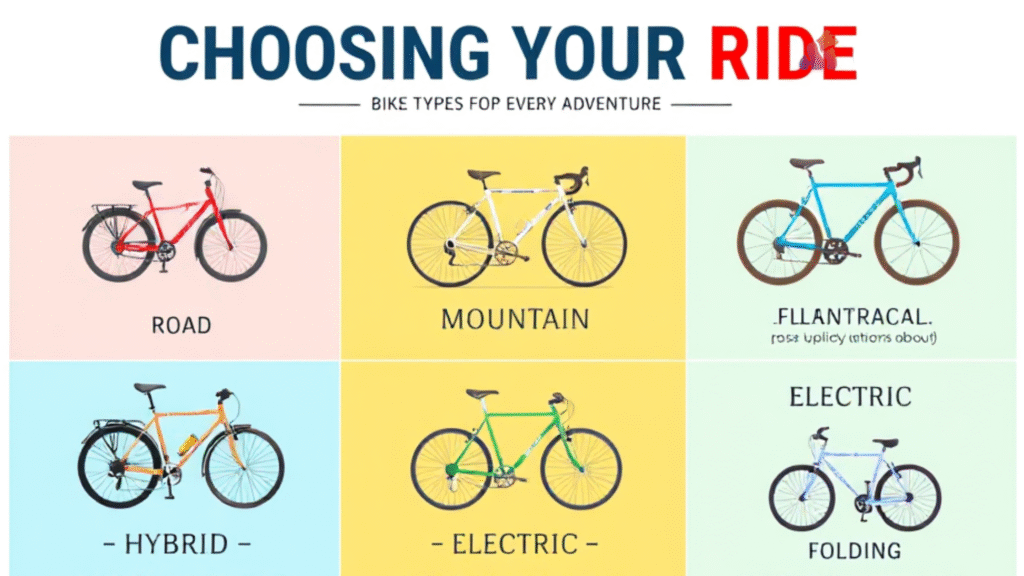
Types of Bicycles: Your Two-Wheeled Options
Now that you know your “why” and “where,” let’s explore the main types of bicycles. Each one is designed for specific kinds of riding. Bicycle Finder
1. Road Bikes 💨
- What they are: Built for speed and efficiency on paved roads. They are lightweight with thin tires and “drop” handlebars (the ones that curve downwards). Bicycle Finder
- Best for:
- Riding fast on smooth roads.
- Long-distance cycling.
- Group rides and racing.
- Commuting on paved paths where speed is important.
- Pros: Very fast, efficient, lightweight.
- Cons: Less comfortable on rough roads, not good off-road, riding position can be aggressive (bent over).
- Look for: Thin tires (23-28mm wide), multiple gears, aerodynamic frames.
2. Mountain Bikes (MTBs) ⛰️
- What they are: Designed to handle rough off-road trails, rocks, roots, and steep hills. They have sturdy frames, wide knobby tires for grip, and often have suspension.
- Best for:
- Riding on dirt trails, gravel, and rocky paths.
- Exploring forests and mountains.
- Getting a great workout on challenging terrain.
- Pros: Durable, excellent grip, comfortable on bumps, upright riding position.
- Cons: Slower on paved roads, heavier than road bikes, knobby tires create more drag.
- Types of MTBs:
- Hardtail: Front suspension only. Good for less extreme trails, more affordable.
- Full Suspension: Suspension on both front and rear wheels. Best for very rough trails, jumps, and drops. More expensive.
- Look for: Wide tires (2.0-2.6 inches), strong brakes (usually disc brakes), flat handlebars.
3. Hybrid Bikes 🛣️🌲
- What they are: The “best of both worlds.” Hybrid bikes combine features from road bikes and mountain bikes. They offer a comfortable, upright riding position, flat handlebars, and tires that can handle both paved roads and light off-road paths.
- Best for:
- Commuting in the city.
- Casual rides on bike paths and light gravel trails.
- Running errands.
- Riders who want versatility and comfort.
- Pros: Comfortable, versatile, good for various surfaces, stable.
- Cons: Not as fast as road bikes, not as rugged as mountain bikes for extreme trails.
- Look for: Medium-width tires (30-45mm), often have mounts for racks and fenders, comfortable saddles. Bicycle Finder
🚲 Pull Quote: “A hybrid bike is like the Swiss Army knife of bicycles – ready for almost anything!”
4. Electric Bikes (E-Bikes) ⚡
- What they are: Bicycles with an electric motor that helps you pedal. They make cycling easier, especially on hills or for longer distances. You still have to pedal, but the motor gives you a “boost.” Bicycle Finder
- Best for:
- Commuting long distances or with hills.
- Riders who want to keep up with faster friends or family.
- Carrying heavy loads (like groceries or kids).
- People who need a little extra help due to fitness or age.
- Pros: Makes cycling less tiring, extends your range, great for hills.
- Cons: Heavier, more expensive, requires charging, can be complex to maintain.
- Types: E-road, E-mountain, E-hybrid, E-cargo. The motor assist levels vary.
- Look for: Battery range, motor power, pedal-assist vs. throttle options.
5. City/Commuter Bikes 🏙️
- What they are: Designed specifically for urban environments and daily use. They often come with fenders (to keep you clean), racks (for carrying bags), and a very upright riding position for comfort and good visibility in traffic. Bicycle Finder
- Best for:
- Daily commutes in the city.
- Short trips to the store or friends’ houses.
- Casual, comfortable rides.
- Pros: Very comfortable, practical, often come with useful accessories.
- Cons: Slower than road bikes, not designed for off-road.
- Look for: Fenders, chain guard, rack mounts, comfortable upright handlebars, often a single gear or internal gears for low maintenance. Bicycle Finder
6. Folding Bikes 🎒
- What they are: Bikes that can be folded into a compact size, making them easy to store, carry on public transport, or fit into small apartments or car trunks.
- Best for:
- Commuting that involves public transport (trains, buses).
- Living in small spaces.
- Travelers who want to take their bike with them.
- Riders who need a bike that is easy to store.
- Pros: Portable, compact, convenient for multi-modal commutes.
- Cons: Smaller wheels can be less smooth over bumps, generally not as fast or efficient as full-sized bikes, can be more expensive for good quality.
- Look for: Folding mechanism quality, folded size, wheel size (usually 16 or 20 inches).
7. Kids’ Bikes 👧👦
- What they are: Bikes designed specifically for children, focusing on safety, durability, and ease of learning. They come in various sizes based on wheel diameter, not frame size. Bicycle Finder
- Best for:
- Teaching children to ride.
- Family rides.
- Developing cycling skills.
- Pros: Safe, durable, appropriate sizing for young riders.
- Cons: Outgrown quickly, less advanced features.
- Look for:
- Balance Bikes: No pedals, for learning balance (ages 2-5).
- 12-inch wheels: With or without training wheels (ages 2-4).
- 16-inch wheels: First pedal bikes, often with coaster brakes (ages 4-6).
- 20-inch wheels: Often with gears and hand brakes, more like adult bikes (ages 6-9).
- 24-inch wheels: For older kids transitioning to adult bikes (ages 8-11).
- Important: Focus on fit and safety features like easy-to-reach brakes.
8. Specialty Bikes 🌟
There are also many other types of bikes designed for very specific purposes: Bicycle Finder
- Gravel Bikes: Like road bikes but with wider tires and a more relaxed geometry to handle gravel roads and light trails.
- Fat Bikes: Have extremely wide tires (4+ inches) for riding on snow, sand, or very soft terrain.
- BMX Bikes: Small, durable bikes for tricks, racing on dirt tracks, or street riding.
- Recumbent Bikes: Riders sit back in a reclined position, often with two or three wheels, for comfort and unique aerodynamics.
- Cargo Bikes: Designed to carry heavy loads or multiple children, often with a large front or rear platform/box.
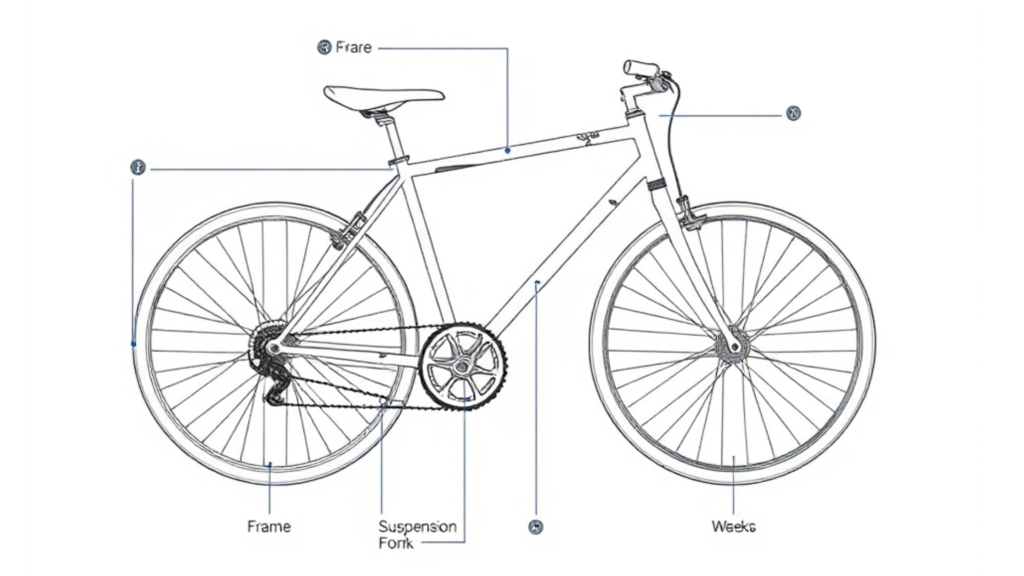
Key Features to Consider: What’s Under the Hood?
Once you have an idea of the bike type, it’s time to dive into some important features. These parts affect how the bike rides, how durable it is, and its price. Bicycle Finder
1. Frame Material 🏗️
The frame is the skeleton of the bike. Its material affects weight, strength, and ride quality.
- Steel:
- Pros: Very durable, comfortable ride (absorbs bumps well), can be repaired easily.
- Cons: Heavier, can rust if not cared for.
- Good for: Commuter bikes, touring bikes, some mountain bikes.
- Aluminum:
- Pros: Lightweight, stiff (good for power transfer), affordable, doesn’t rust.
- Cons: Can feel a bit “harsh” on bumpy roads (less shock absorption), can crack if severely damaged.
- Good for: Most entry-to-mid level road, mountain, and hybrid bikes.
- Carbon Fiber:
- Pros: Very lightweight, excellent at absorbing road vibrations (comfortable ride), can be shaped into aerodynamic designs.
- Cons: Expensive, can be brittle if hit hard, difficult to repair.
- Good for: High-end road bikes, mountain bikes, and e-bikes where weight and performance are key.
- Titanium:
- Pros: Lightweight, very durable, rust-proof, smooth ride quality (like steel but lighter).
- Cons: Very expensive, harder to find.
- Good for: High-end, long-lasting bikes.
2. Gears (Drivetrain) ⚙️
Gears allow you to pedal comfortably whether you’re climbing a steep hill or speeding down a flat road.
- How many gears? Bikes can have anywhere from 1 (single-speed) to 30+ gears. More gears give you more options for different terrains.
- Single-speed: Simple, low maintenance, good for flat areas.
- Many gears (e.g., 2×10, 1×12): Essential for hilly areas or if you want to ride fast and efficiently.
- Shifters: How you change gears.
- Trigger shifters: Common on mountain and hybrid bikes, easy to use with your thumb and index finger.
- Twist shifters: Found on some kids’ and entry-level bikes, you twist a part of the grip.
- Integrated shifters (road bikes): Brake and shift levers are combined for quick changes. Bicycle Finder
3. Brakes 🛑
Brakes are crucial for safety!
- Rim Brakes (V-Brakes, Caliper Brakes):
- How they work: Pads squeeze against the rim of the wheel.
- Pros: Lighter, less expensive, easy to maintain.
- Cons: Less effective in wet conditions, can wear out wheel rims over time.
- Good for: Road bikes, hybrid bikes, entry-level bikes.
- Disc Brakes:
- How they work: Pads squeeze a rotor (disc) attached to the wheel hub.
- Pros: Excellent stopping power in all weather conditions, don’t wear out rims.
- Cons: Heavier, more expensive, can be harder to maintain (especially hydraulic).
- Types:
- Mechanical Disc Brakes: Cable-activated, simpler.
- Hydraulic Disc Brakes: Fluid-activated, provide more power and better feel.
- Good for: Mountain bikes, e-bikes, gravel bikes, higher-end road and hybrid bikes.
4. Suspension 🤸
Suspension helps absorb shocks and bumps from the road or trail, making your ride more comfortable and controlled. Bicycle Finder
- No Suspension (Rigid):
- Pros: Lighter, more efficient (all your pedaling power goes to the wheels), less maintenance.
- Cons: Uncomfortable on rough surfaces.
- Good for: Road bikes, city bikes, some hybrid bikes.
- Front Suspension (Hardtail):
- Pros: Absorbs bumps from the front wheel, more comfortable on light trails than rigid.
- Cons: Rear wheel still feels bumps.
- Good for: Mountain bikes, some hybrid bikes.
- Full Suspension:
- Pros: Absorbs bumps from both front and rear wheels, very comfortable and controlled on rough terrain.
- Cons: Heavier, more expensive, requires more maintenance, less efficient on smooth roads.
- Good for: Serious mountain biking.
5. Wheel Size & Tires 🔄
The size of your wheels and the type of tires make a big difference in how a bike performs.
- Wheel Sizes:
- 700c (Road Bikes): Large diameter, rolls fast and efficiently on paved roads.
- 29-inch (Mountain Bikes): Good for rolling over obstacles, fast on trails.
- 27.5-inch (Mountain Bikes): Nimble, good balance of speed and agility.
- 26-inch (Older MTBs, Kids’ Bikes): Smaller, strong, quick acceleration.
- 20-inch (Folding Bikes, BMX, Kids’ Bikes): Compact, maneuverable.
- Tires:
- Width: Narrow tires (23-28mm) are fast on roads. Wider tires (30mm+) offer more comfort and grip. Very wide tires (2.0+ inches) are for off-road.
- Tread: Smooth tires (slicks) are for pavement. Knobby tires are for grip on dirt and loose surfaces. Semi-slick tires have a smooth center and knobby sides for mixed use.
6. Handlebars 🤝
The shape of your handlebars affects your riding position and comfort.
- Drop Bars: Curved bars that offer multiple hand positions, allowing you to change your body position for aerodynamics or comfort. Common on road bikes.
- Flat Bars: Straight bars that provide an upright, relaxed riding position. Common on mountain, hybrid, and city bikes.
- Riser Bars: A type of flat bar that sweeps up slightly, giving a more upright and comfortable position. Common on mountain and comfort bikes.
7. Saddle (Seat) 🛋️
The saddle is where you make contact with the bike. Comfort is key!
- Road saddles: Often narrow and firm, designed for efficiency when leaning forward.
- Mountain/Hybrid saddles: Wider and more padded for an upright position.
- Comfort saddles: Very wide and soft, sometimes with springs, for maximum comfort on casual rides.
- Tip: Don’t judge a saddle by its padding alone. Sometimes firmer, well-shaped saddles are more comfortable on longer rides. You can always swap out a saddle if it’s not comfortable. Bicycle Finder
8. Accessories 🎒💡
Think about what you’ll need with your bike: Bicycle Finder
- Helmet: Non-negotiable for safety! ⛑️
- Lights: Front and rear lights are essential for riding in low light or at night. 💡
- Lock: To protect your investment. 🔒
- Water Bottle Cage & Bottle: Stay hydrated! 💧
- Fenders: Keep mud and water from splashing you.
- Racks & Panniers: For carrying groceries, commuting gear, or touring bags.
- Kickstand: Convenient for parking.
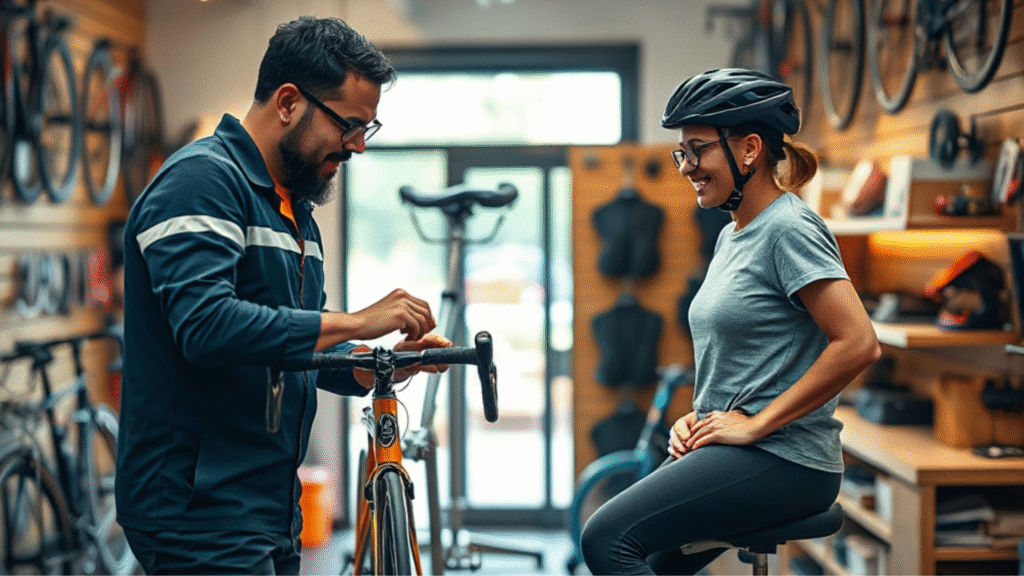
Sizing and Fit: The Perfect Match 📏
Imagine wearing shoes that are too big or too small – uncomfortable, right? The same goes for bikes! A bike that fits you correctly is crucial for: Bicycle Finder
- Comfort: You’ll enjoy riding more and avoid aches and pains.
- Efficiency: You’ll pedal more powerfully and easily.
- Safety: You’ll have better control of the bike.
How to Find Your Size: Bicycle Finder
- Standover Height: This is the most important measurement. When you stand over the bike with both feet flat on the ground, there should be 1-2 inches (2.5-5 cm) of space between your body and the top tube (the horizontal bar of the frame). For mountain bikes, you might want a bit more space (2-4 inches) for clearance on trails.
- Reach: This refers to how far you have to reach for the handlebars. Your arms should be slightly bent, not locked straight. Bicycle Finder
- Frame Size: Bike frame sizes are usually given in inches or centimeters, or sometimes as S, M, L, XL. These sizes refer to the length of the seat tube (from the pedals to where the seat post goes in).
- Online Size Charts: Most bike brands have size charts on their websites that match bike sizes to your height and inseam (the length of your leg from the ground to your crotch). Use these as a starting point.
- Professional Bike Fitting: For serious riders or if you have specific comfort issues, a professional bike fit at a local bike shop is highly recommended. They use special tools and knowledge to adjust the bike perfectly to your body. Bicycle Finder
🚴♂️ Pull Quote: “A bike that fits you well isn’t just comfortable, it’s safer and more fun to ride!”
Budgeting for Your Bike: What Will It Cost? 💰
Bikes come in a huge range of prices, from a few hundred dollars to several thousands. Knowing your budget helps manage expectations and narrow choices. Bicycle Finder
Price Ranges:
- Entry-Level ($300 – $700):
- Good for casual riders, short commutes, light recreational use.
- Frames typically aluminum or steel.
- Components (gears, brakes) will be basic but functional.
- You’ll find basic hybrid, city, and mountain bikes here.
- Mid-Range ($700 – $1,500):
- Great for more serious riders, longer commutes, more challenging trails, or fitness goals.
- Lighter frames, better quality components that are more durable and perform better.
- You’ll find solid road bikes, capable mountain bikes, and higher-end hybrids.
- High-End ($1,500+):
- For performance-focused riders, racers, or enthusiasts who want the best.
- Often carbon fiber frames, very lightweight, advanced components, and specialized features.
- This range includes high-performance road, mountain, and electric bikes. Bicycle Finder
Don’t Forget Accessories! ⛑️💡🔒
Remember to set aside some money for essential accessories. A common mistake is spending all your budget on the bike and having nothing left for a helmet, lights, or a lock. These are not optional extras; they are vital for safety and enjoyment.
New vs. Used Bikes ♻️
- New:
- Pros: Full warranty, latest features, professional assembly and support from the shop.
- Cons: Higher price.
- Used:
- Pros: Can get a great deal, good for trying out cycling without a huge investment.
- Cons: No warranty, might need repairs, harder to know the bike’s history, no professional fitting.
- Tip: If buying used, always inspect the bike thoroughly or have a bike mechanic check it out for you. Look for cracks in the frame, worn-out components, or bent wheels. Bicycle Finder
Want To Know About 15 Mountain Bikes This Year
Where to Buy Your Perfect Bike 🛍️
You have a few options when it comes to purchasing your bike, each with its own pros and cons. Bicycle Finder
1. Local Bike Shops (LBS) 🏪
- Pros:
- Expert Advice: Staff are knowledgeable and can help you find the right bike and size.
- Test Rides: You can try out different bikes on the spot. Bicycle Finder
- Professional Fitting: Many offer basic fitting services with your purchase.
- After-Sale Support: Often include free tune-ups, warranty support, and repairs.
- Community: Support a local business and become part of the cycling community.
- Cons:
- Generally higher prices than online retailers.
- Limited selection compared to online.
2. Online Retailers 🌐
- Pros:
- Wider Selection: Access to many brands and models.
- Often Lower Prices: Competitive pricing, especially during sales.
- Convenience: Shop from home.
- Cons:
- No Test Ride: You can’t try before you buy, making sizing tricky.
- Assembly Required: Bikes often arrive partially disassembled, requiring some technical skill or a trip to a bike shop for assembly.
- No Personal Advice: You rely on reviews and online guides.
- Returns can be difficult: Shipping a bike back is a hassle.
- Tip: If buying online, be absolutely sure of your size and be prepared for some assembly. Bicycle Finder
3. Used Market (Online Classifieds, Local Sales) 🤝
- Pros:
- Great Deals: You can find excellent bikes at a fraction of their original price.
- Sustainable: Giving a bike a second life.
- Cons:
- “As Is” Condition: No warranty, potential hidden problems.
- Requires Knowledge: You need to know what to look for to avoid buying a lemon.
- No Support: You’re on your own for repairs and maintenance.
- Tip: Always meet in a safe, public place. Bring a friend who knows bikes if you’re not confident. Bicycle Finder
The All-Important Test Ride! 🚴♀️💨
No matter how much research you do or how good a bike looks on paper, you must test ride it before buying! This is the single most important step in finding your perfect bike.
What to Do During a Test Ride: Bicycle Finder
- Ride More Than a Few Feet: Don’t just ride around the block. If possible, ride for 10-15 minutes. Try to go up a small hill, shift through all the gears, and use the brakes.
- Listen and Feel:
- Does anything creak or clunk?
- Are the brakes smooth and strong?
- Do the gears shift easily and quietly?
- Does the saddle feel comfortable (even if it’s just for a short ride)?
- Does the steering feel natural and responsive?
- Check Your Position:
- Are your arms slightly bent?
- Do your knees feel good when pedaling?
- Can you comfortably reach the brakes and shifters?
- Is your posture comfortable for the type of riding you plan to do?
- Try Different Bikes: If you’re deciding between a road bike and a hybrid, or two different sizes of the same bike, ride both! The difference might surprise you.
- Don’t Rush: Take your time. A good bike shop will encourage you to ride as much as you need to feel confident. Bicycle Finder
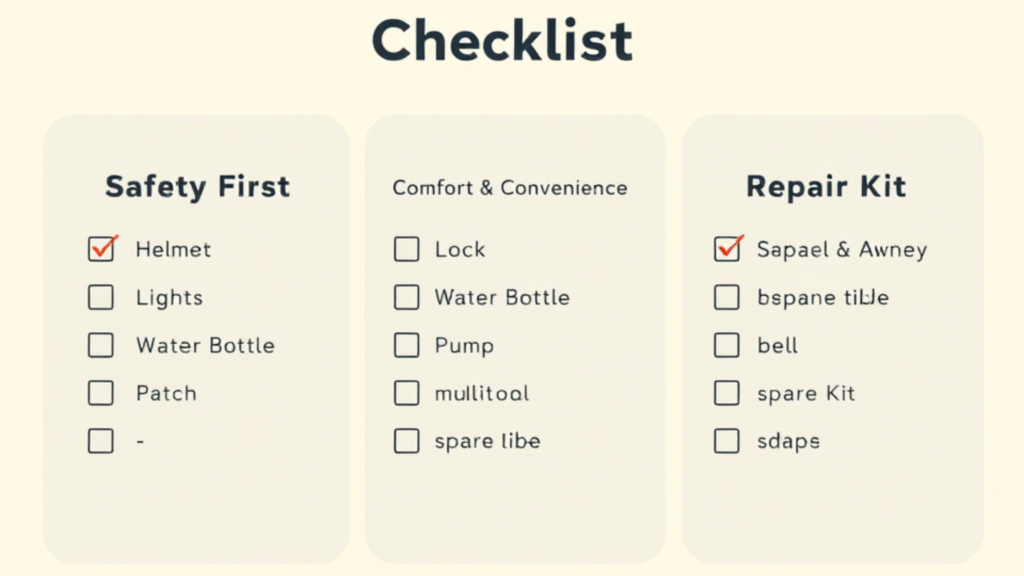
Basic Bike Maintenance: Keep Your Ride Happy! 🛠️
Once you have your perfect bike, a little regular care will keep it running smoothly and safely for years. You don’t need to be a mechanic to do basic checks! Bicycle Finder
The “ABC Quick Check” before Every Ride: Bicycle Finder
- A – Air: Check your tire pressure. Tires should be firm. Look for the recommended pressure on the side of your tire. Bicycle Finder
- B – Brakes: Squeeze both brake levers. They should feel firm and stop the wheel quickly. Make sure the brake pads are hitting the rim or disc squarely.
- C – Chain: Is your chain clean and lubricated? A dry, rusty chain makes noise and wears out faster.
- Quick Release: Check that all quick-release levers (on wheels, seat post) are closed securely.
Regular Cleaning and Lube: Bicycle Finder
- Clean Your Bike: After dusty or muddy rides, wipe down your frame and components.
- Lube Your Chain: Apply a small amount of bike-specific chain lube every few rides, especially after riding in wet conditions. Wipe off any excess.
When to See a Professional: Bicycle Finder
- If you hear strange noises you can’t identify.
- If your gears aren’t shifting smoothly after basic adjustments.
- If your brakes feel spongy or aren’t stopping well.
- For major repairs or yearly tune-ups.
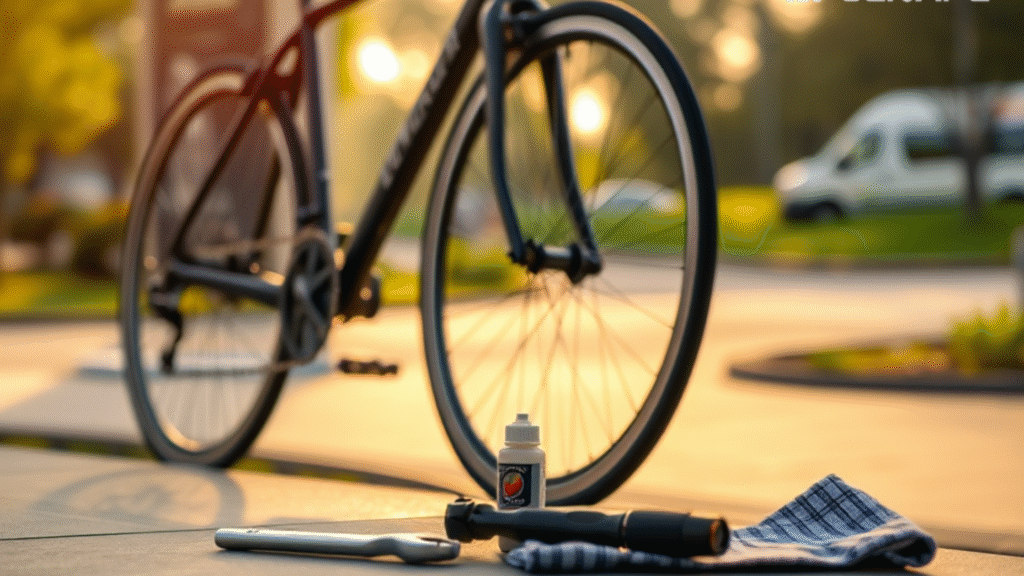
Conclusion: Your Journey Awaits! ✨
Finding the perfect bicycle Finder for your lifestyle is an exciting adventure in itself! By taking the time to understand your needs, learning about different bike types and features, and prioritizing a proper fit, you’ll be well on your way to making a smart choice.
Bicycle Finder Remember, the best bike for you isn’t necessarily the most expensive or the fastest; it’s the one that makes you want to ride it every single day. So, go ahead, do your research, visit some bike shops, take those test rides, and get ready to enjoy the freedom, fun, and fitness that cycling brings. Happy riding! 🚲💨
Find Your Perfect Bike! 🚲
Answer a few quick questions to get a personalized bike recommendation based on your needs.
Your Recommended Bike Types:
Remember to test ride any bike before buying to ensure it’s the perfect fit for you!
